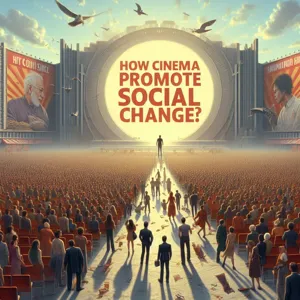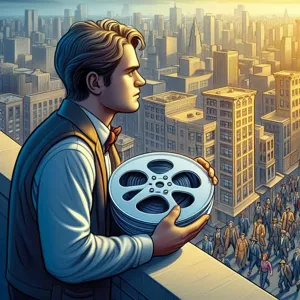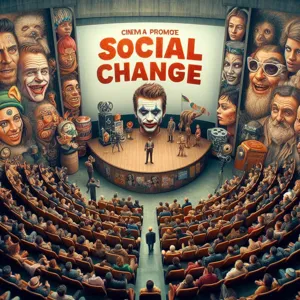In an age where visual storytelling reigns supreme, cinema has emerged as a powerful catalyst for social change, transcending borders and cultures to ignite conversations and inspire movements.
From thought-provoking documentaries to gripping narratives that challenge the status quo, films have the unique ability to shine a spotlight on societal issues, giving voice to the marginalized and shedding light on injustices that often go unnoticed. As audiences sit captivated in darkened theaters, they are not just passive viewers; they become part of a larger dialogue, driven to reflect on their beliefs, question societal norms, and, ultimately, take action. In this blog post, we will delve into the profound relationship between cinema and social activism, exploring how filmmakers have harnessed the magic of the silver screen to advocate for change and inspire audiences to envision a better world. Join us as we uncover the stories behind the films that have sparked revolutions, reshaped perceptions, and ignited a passion for justice among viewers across the globe.
1. Introduction: The Power of Cinema in Society

Cinema has long been more than just a medium for entertainment; it is a powerful catalyst for social change and a mirror reflecting the complexities of human experience. From the silent films of the early 20th century to the thought-provoking narratives of today, the silver screen has the unique ability to transcend cultural boundaries and resonate with audiences on an emotional level. Through compelling storytelling, filmmakers can illuminate pressing societal issues, challenge prevailing norms, and inspire action, making cinema an essential tool for advocacy and awareness.
Consider the profound impact of films like “12 Years a Slave,” which brought the horrors of slavery to contemporary audiences, or “The Pursuit of Happyness,” which highlighted the struggles of homelessness and perseverance. These stories do not just entertain; they educate and provoke critical conversations about race, poverty, and justice. Cinema invites viewers to step into the shoes of others, fostering empathy and understanding in a world often divided by differences.
Moreover, the rise of independent cinema has further democratized storytelling, allowing marginalized voices to share their narratives and contribute to the broader discourse on social issues. With the advent of digital platforms, filmmakers now have the ability to reach global audiences, amplifying their messages and sparking movements that might not have received attention in more traditional formats.
In this exploration of how cinema sparks social change, we will delve into the ways films have influenced public perception, motivated grassroots movements, and shaped policy discussions. From documentaries that expose uncomfortable truths to fictional narratives that inspire hope and resilience, the power of cinema in society is undeniable. Join us as we uncover the layers of this fascinating relationship between film and social transformation, and discover how lights, camera, and action can lead to meaningful change.
2. Historical Context: Cinema as a Catalyst for Change
Cinema has long served as a mirror to society, reflecting the complexities of the human experience and the sociopolitical landscapes in which we find ourselves. From the early days of silent films to the modern-day blockbusters, the silver screen has captured the essence of cultural shifts and movements, often acting as a catalyst for change. Understanding the historical context of cinema reveals how filmmakers have used their art to challenge societal norms, provoke thought, and inspire action.
In the 1930s and 1940s, films like *The Grapes of Wrath* showcased the struggles of the Great Depression, highlighting issues of poverty and injustice that resonated deeply with audiences. This era marked a turning point where cinema began to take on a more significant role in social commentary. As World War II loomed, films such as *Casablanca* not only entertained but also served to reinforce themes of resistance against tyranny, encouraging viewers to reflect on their own moral convictions.
The civil rights movement of the 1960s saw a surge in films that addressed racial inequality and social injustice. Movies like *Guess Who’s Coming to Dinner* and *Malcolm X* opened up dialogues about race relations in America, challenging audiences to confront their biases and consider the consequences of systemic racism. Filmmakers became storytellers and advocates, using their platforms to shine a light on marginalized voices and galvanize public sentiment.
As we moved into the late 20th and early 21st centuries, cinema continued to evolve as a powerful instrument for change, tackling issues such as LGBTQ+ rights, environmental concerns, and economic disparity. Films like *Brokeback Mountain* and *The Pursuit of Happyness* not only entertained but also educated viewers about the struggles faced by individuals in these communities, fostering empathy and understanding.
Today, as we witness the rise of streaming platforms and global cinema, the potential for film to instigate social change has never been greater. Documentaries and narrative films alike are being utilized to raise awareness about pressing issues, from climate change to mental health, reaching wider audiences than ever before. Cinema, in its rich history, has proven time and again that it is not merely a form of entertainment; it is a powerful agent of social change capable of inspiring action, fostering dialogue, and ultimately transforming society.
3. Case Study: Iconic Films That Changed Public Perception

Throughout history, cinema has played a pivotal role in shaping societal attitudes and provoking thought around pressing issues. Iconic films serve not only as entertainment but as catalysts for social change, challenging viewers to confront uncomfortable truths and reconsider their perspectives. One compelling case study is the film “To Kill a Mockingbird” (1962), based on Harper Lee’s novel. Set in the racially charged atmosphere of the American South during the 1930s, the film’s portrayal of racial injustice through the eyes of a young girl, Scout Finch, opened the door for dialogue about racism and empathy in a time when such discussions were often silenced. Its impact was profound, influencing public perception and contributing to the civil rights movement in the 1960s.
Another landmark film, “Philadelphia” (1993), brought the HIV/AIDS crisis into mainstream consciousness at a time when stigma and misinformation were rampant. By humanizing the experiences of those affected through the powerful story of Andrew Beckett, played by Tom Hanks, the film challenged societal perceptions of the disease and the LGBTQ+ community. It not only educated audiences but also fostered compassion, encouraging conversations that were long overdue.
More recently, “Black Panther” (2018) made waves by presenting a superhero narrative that centered on African culture and representation. The film was celebrated not just for its entertainment value, but for its role in challenging Hollywood’s long-standing lack of diversity. It sparked discussions about representation in media and inspired a generation to embrace their heritage and identities.
These films, among many others, illustrate cinema’s unique ability to evoke empathy, challenge stereotypes, and inspire social movements. They remind us that while the silver screen may be a source of escapism, it is also a powerful platform for storytelling that can lead to meaningful change in society. By capturing the complexities of human experience, these iconic films continue to resonate, reminding us of the profound impact that cinema can have in shaping public perception and sparking social change.
4. The Role of Documentaries in Raising Awareness
Documentaries have emerged as a powerful medium for raising awareness about pressing social issues, effectively bridging the gap between art and activism. Unlike traditional films that primarily aim to entertain, documentaries delve into real-life stories, presenting factual narratives that illuminate the complexities of the world around us. By showcasing the struggles, triumphs, and everyday realities of marginalized communities, documentaries inspire empathy and provoke thought among viewers, compelling them to engage with critical topics in a meaningful way.
One striking example is the documentary “13th,” directed by Ava DuVernay, which explores the intersection of race, justice, and mass incarceration in the United States. By weaving together historical context, personal testimonies, and expert analysis, the film not only educates audiences about systemic racism but also mobilizes them to advocate for criminal justice reform. This is the essence of the documentary’s power: it transforms passive viewers into informed citizens, igniting conversations that ripple far beyond the theater walls.
Moreover, the accessibility of documentaries in the digital age has further amplified their impact. Platforms like Netflix and youtube allow these films to reach global audiences, fostering a sense of shared responsibility and urgency around social issues. Whether it’s climate change, poverty, or human rights abuses, documentaries serve as a call to action, urging viewers to consider their role in creating change.
In essence, documentaries are not just vehicles for storytelling; they are catalysts for social awareness and change. By shedding light on underrepresented voices and critical issues, they empower audiences to take action, advocate for justice, and contribute to a more informed and compassionate society. As we continue to navigate complex global challenges, the role of documentaries in shaping public consciousness and driving social change remains more vital than ever.
5. How Fictional Narratives Reflect Social Issues

Fictional narratives have an incredible power to reflect and amplify social issues, serving as both a mirror to society and a catalyst for change. Through storytelling, filmmakers can illuminate the complexities of human experiences, revealing the struggles, triumphs, and nuances of marginalized communities.
Consider the impact of films like “12 Years a Slave,” which lays bare the horrors of slavery, or “Parasite,” which critiques class disparities through the lens of dark humor and suspense. These narratives do more than entertain; they invite audiences to confront uncomfortable truths about their society and themselves. By embedding social issues within engaging plots, filmmakers have the unique ability to foster empathy and spark discussions that might otherwise remain silent.
Moreover, the fictional medium allows for exploration beyond the confines of reality. It can imagine futures free from systemic oppression or showcase what is possible when individuals unite for a common cause. Animated films aimed at younger audiences, such as “Zootopia,” tackle themes like prejudice and acceptance, teaching valuable lessons about tolerance and diversity in a way that resonates with children and adults alike.
As viewers connect with characters and their journeys, they are often inspired to reflect on their own beliefs and actions. This emotional engagement can translate into real-world activism, motivating audience members to advocate for change in their communities. Through screenings, discussions, and grassroots movements sparked by films, the power of storytelling can transcend the screen, transforming fictional narratives into actionable social change. In this way, cinema not only reflects social issues but also challenges audiences to envision a better world and take steps toward making it a reality.
6. The Influence of Filmmakers and Activists
In the realm of cinema, the intertwining paths of filmmakers and activists create a powerful force for social change. These artists wield their cameras like brushes, painting vivid narratives that not only entertain but also provoke thought and inspire action. Many filmmakers have emerged as passionate advocates, using their platforms to address pressing social issues. From documentaries that shed light on environmental crises to feature films that explore systemic injustice, the stories told on screen can ignite movements and mobilize communities.
Consider the impact of films like *Selma*, which chronicles the Civil Rights Movement, or *An Inconvenient Truth*, which brought climate change to the forefront of public consciousness. These films do more than tell a story; they serve as catalysts for dialogue and debate, compelling audiences to reflect on their values and beliefs. Filmmakers often collaborate with activists to ensure that the narratives they present are authentic and resonate with the lived experiences of those they aim to represent. Through this collaboration, they create a bridge between the art of cinema and the urgent call for social justice.
Moreover, social media has amplified the voices of both filmmakers and activists, allowing their messages to reach a global audience in real time. Campaigns that accompany films, such as hashtag movements and community outreach initiatives, further engage viewers and encourage them to take action. By harnessing the power of storytelling, filmmakers and activists together challenge the status quo, urging society to confront uncomfortable truths and inspiring a collective commitment to change.
In this dynamic interplay, the influence of filmmakers and activists is undeniable. They remind us that cinema is not just an escape from reality, but a mirror reflecting the world’s complexities, inviting us to engage, empathize, and ultimately, act. Through their dedication to social causes, these creative visionaries illuminate pathways to progress, proving that the magic of cinema can indeed spark meaningful social change.
7. Audience Engagement: Cinema’s Impact on Public Discourse

In an era where social media dominates communication, cinema remains a powerful medium for shaping public discourse and engaging audiences in meaningful conversations. Movies have the unique ability to transcend cultural barriers and evoke emotions, prompting viewers to reflect on societal issues that may have previously gone unnoticed. This impact is particularly evident in films that tackle pressing topics such as racial inequality, climate change, mental health, and gender rights.
Imagine a film that tells the poignant story of an immigrant family navigating the complexities of their new life. As viewers watch their struggles and triumphs unfold on screen, they are not merely passive observers; they become emotionally invested in the characters’ journeys. This emotional engagement can lead to a deeper understanding of the nuanced realities faced by marginalized communities. When audiences leave the theater, they carry with them not just the story, but also a heightened awareness of the issues at hand, often sparking discussions with friends and family that extend far beyond the credits.
Moreover, cinema has the power to mobilize audiences. Documentaries like “13th” and “An Inconvenient Truth” have ignited public discourse and inspired grassroots movements, showing how storytelling can be a catalyst for action. By presenting compelling narratives backed by research and real-life experiences, these films encourage viewers to question the status quo and advocate for change. The conversations generated by such films can lead to community events, social media campaigns, and even policy discussions, amplifying their impact on public consciousness.
In a digital age where attention spans are fleeting, cinema’s ability to engage audiences through powerful storytelling and visual artistry is unparalleled. As filmmakers continue to push boundaries and address societal challenges head-on, they not only entertain but also empower viewers to become informed, empathetic, and active participants in the global dialogue surrounding social change. Ultimately, cinema serves as a mirror reflecting our realities, a lens magnifying our shared experiences, and a platform for voices that demand to be heard.
8. The Power of Representation in Film
The power of representation in film cannot be overstated. Cinema has a unique ability to reflect societal values and beliefs, often acting as a mirror that reveals the complexities of human experiences. When diverse voices and stories are portrayed on screen, they foster a deeper understanding of different cultures, identities, and perspectives. This representation is crucial in shaping public perception and dialogue, challenging stereotypes, and dismantling prejudices that have long been ingrained in society.
Consider the impact of films that center on underrepresented groups—whether it’s stories of women, people of color, the LGBTQ+ community, or individuals with disabilities. These narratives not only validate the existence and experiences of marginalized communities but also inspire empathy and compassion in broader audiences. Films like “Black Panther,” “Moonlight,” and “Parasite” have not only captivated viewers but also sparked conversations about representation, identity, and social justice. They highlight the importance of authenticity in storytelling, demonstrating that when people see themselves reflected in media, it can empower and uplift entire communities.
Moreover, representation in film extends beyond the stories themselves; it also encompasses the people behind the camera. Diverse filmmakers, writers, and actors bring unique perspectives that enrich the storytelling landscape. By promoting inclusivity in the industry, we pave the way for more authentic narratives that resonate with a wider audience. The ripple effect of these films can inspire social movements, influence policy changes, and encourage individuals to take action in their own communities.
In essence, the representation in film is not just about visibility; it is about creating a space where all stories are valued and recognized. As audiences increasingly demand authentic portrayals, the film industry has the power to drive social change by championing diversity, fostering understanding, and promoting acceptance. As we spotlight stories that matter, we ignite conversations that can lead to a more inclusive and equitable society.
9. Social Media and the Amplification of Cinema’s Message
In today’s digital landscape, social media serves as a powerful conduit for amplifying the messages conveyed through cinema. The synergy between film and social media platforms has transformed the way audiences engage with cinematic narratives, allowing for a broader reach and deeper impact. When a new film addresses pressing social issues—be it climate change, racial equality, or mental health—the conversation doesn’t stop when the credits roll. Instead, it ignites a dialogue that spills over into social media, where millions of users share their thoughts, reactions, and interpretations, thereby generating buzz and fostering community around these topics.
Consider how films like *Parasite* or *13th* have not only captured critical acclaim but have also spurred movements and discussions online. Hashtags take flight as viewers rally around shared experiences, urging others to watch and reflect. This collective engagement can lead to increased awareness and even mobilization, as social media acts as a platform for advocacy. Filmmakers and actors leverage their online presence to promote their projects, often sharing behind-the-scenes content, personal anecdotes, or live Q&A sessions that humanize the issues at hand and invite audiences into the conversation.
Moreover, social media enables real-time reactions and discussions, allowing viewers to dissect scenes, analyze themes, and share personal stories related to the film’s message. This interactive layer encourages a sense of ownership among audiences, making them feel like active participants in the narrative rather than passive consumers. As viewers contribute their voices and perspectives, they help to shape the ongoing discourse surrounding the film, further solidifying its cultural relevance.
In essence, social media not only amplifies the reach of cinematic messages but also transforms them into catalysts for social change. As stories traverse platforms, they inspire action, foster empathy, and encourage a deeper understanding of complex societal issues. By harnessing the power of social media, cinema continues to spark conversations that resonate far beyond the screen, proving that lights, camera, and action can indeed lead to meaningful change.
10. The Role of Film Festivals in Promoting Social Change
Film festivals have long been a vibrant hub for cinematic expression, but their role in promoting social change has become increasingly vital in today’s cultural landscape. These events serve as a powerful platform where filmmakers can showcase works that challenge societal norms, highlight pressing issues, and inspire audiences to think critically about the world around them.
At festivals like Sundance, Cannes, and Toronto, documentaries and narrative films alike tackle subjects ranging from climate change and social justice to mental health and inequality. By bringing these stories to the forefront, festivals not only amplify marginalized voices but also foster crucial conversations among attendees, industry professionals, and the media. The atmosphere buzzes with energy as filmmakers engage in panel discussions, Q&A sessions, and workshops, allowing for a deeper understanding of the themes presented in their films.
Moreover, film festivals often attract diverse audiences, creating a melting pot of perspectives and ideas. This communal experience can ignite a sense of solidarity and urgency, motivating viewers to take action in their own communities. Whether it’s through grassroots organizing, advocacy, or simply raising awareness on social media, the impact of a thought-provoking film can extend far beyond the screen.
In addition to showcasing films, many festivals actively support initiatives that promote social change. This might include partnerships with non-profit organizations, funding for socially conscious projects, or awards that recognize films with significant social impact. By intertwining the arts with activism, film festivals cultivate an environment where creativity meets purpose, inspiring filmmakers and viewers alike to envision a better world.
Ultimately, the role of film festivals in promoting social change is invaluable. They not only celebrate the art of cinema but also harness its potential to educate, inspire, and mobilize audiences for a cause. As we continue to navigate complex social issues, these festivals stand as a beacon of hope, reminding us that through storytelling, we can spark meaningful change.
11. Challenges in Using Cinema for Activism
While cinema possesses an incredible ability to inspire and mobilize, it is not without its challenges when utilized for activism. One of the most significant hurdles is the inherent nature of film as a medium; it often requires substantial resources, time, and collaboration to produce a single piece. Independent filmmakers may struggle to secure funding, leading to limited distribution and exposure. Without the backing of major studios, important narratives can remain unheard or unseen, stymying their potential impact on social movements.
Moreover, there’s the challenge of audience reception. Films that tackle difficult or controversial subjects can polarize viewers, leading to resistance rather than dialogue. Some audiences may approach these films with preconceived notions or biases that inhibit their ability to engage with the intended message. This divide can create an echo chamber effect, where only like-minded individuals champion the cause, leaving the broader public untouched.
Additionally, the commercialization of cinema can dilute activist messages. In an industry often driven by profit, films may prioritize entertainment value over genuine storytelling, leading to the oversimplification of complex social issues. This trend can reduce powerful narratives to mere spectacles, undermining their potential to foster understanding and change.
Finally, the fleeting nature of cinematic engagement poses a substantial obstacle. A film may spark interest and discussion upon its initial release, but without ongoing dialogue and action, the momentum can wane. Activism requires sustained effort and commitment, and a single film, no matter how impactful, cannot shoulder this responsibility alone.
Despite these challenges, many filmmakers and activists continue to forge ahead, leveraging the power of cinema to educate, inspire, and provoke thought. By addressing these obstacles head-on, they can enhance the efficacy of film as a tool for social change and ensure that its transformative potential is realized.
12. Success Stories: Films that Sparked Movements
Throughout history, cinema has served as a powerful catalyst for social change, with numerous films igniting movements and inspiring audiences to take action. These success stories illustrate how storytelling, when paired with compelling visuals and poignant narratives, can resonate deeply with viewers, prompting them to reflect on societal issues and advocate for change.
Take, for example, **”Selma” (2014)**, a poignant depiction of the civil rights movement, focusing on the historic march from Selma to Montgomery. This film not only brought the struggles of activists to the forefront of public consciousness but also reignited conversations around racial inequality and voter suppression in America. Its release coincided with a surge in voter registration drives, demonstrating how cinema can galvanize support for urgent social issues.
Similarly, **”The Pursuit of Happyness” (2006)**, based on the true story of Chris Gardner, highlights the challenges of homelessness and the pursuit of the American Dream. By showcasing the resilience of the human spirit in the face of adversity, the film inspired countless individuals to advocate for policies that address poverty and homelessness, proving that powerful narratives can transcend the screen and lead to grassroots movements.
Another noteworthy example is **”The Hate U Give” (2018)**, which tackles systemic racism and police brutality through the eyes of a young girl who witnesses her friend’s unjust shooting. This film not only sparked discussions around the Black Lives Matter movement but also encouraged a new generation of activists to raise their voices against injustice, illustrating the profound impact that such narratives can have on society.
These films, among many others, serve as reminders that cinema is not merely entertainment; it is a formidable tool for social change. By shining a light on pressing issues, they inspire audiences to engage, educate themselves, and take actionable steps towards a more just and equitable world. In an age where the power of film continues to evolve, it is essential to recognize and harness this potential to drive meaningful change.
13. Future Trends: The Evolution of Cinema and Social Advocacy
As we look to the horizon of cinema, it’s clear that the landscape is evolving in ways that both reflect and shape societal values. The future of film is not just about entertainment; it is increasingly becoming a powerful medium for social advocacy and change. With the advent of advanced technology and shifting audience expectations, filmmakers are harnessing new tools to amplify voices that have long been marginalized.
One of the most exciting trends is the rise of virtual reality (VR) and augmented reality (AR) experiences in storytelling. These immersive technologies allow audiences to step into the shoes of others, experiencing life from different perspectives in a visceral way. Imagine being able to walk through a refugee camp or witness the struggles of an underrepresented community—this level of engagement can evoke empathy and spur action in ways traditional film cannot.
Moreover, the democratization of filmmaking through accessible technology is paving the way for diverse narratives. With smartphones and affordable editing software, aspiring filmmakers from all backgrounds can share their stories, leading to a rich tapestry of voices that challenge the status quo. Platforms like YouTube and TikTok are not just outlets for entertainment but also social platforms where activism can be seamlessly woven into creative expression.
Social media’s role in cinema cannot be overlooked either. Filmmakers are increasingly utilizing these platforms to rally support for social causes, create awareness, and mobilize audiences, often blurring the lines between film promotion and grassroots activism. Hashtags such as #OscarsSoWhite or #MeToo have sparked conversations that extend far beyond the screen, showcasing the power of cinema to ignite social movements.
As we move forward, we can expect a continued fusion of storytelling and social justice, where films not only entertain but also educate and inspire. This evolving relationship between cinema and advocacy is a testament to the belief that art can drive change. The future of film is bright, and as audiences, we must embrace this evolution and support narratives that challenge, enlighten, and ultimately transform our society.
14. How to Support Films that Aim for Social Change
Supporting films that aim for social change is a powerful way to amplify important messages and contribute to a collective movement toward a better society. Here are several impactful ways you can lend your support to these transformative projects.
First and foremost, consider attending screenings or film festivals that showcase socially conscious cinema. These events not only provide a platform for filmmakers but also create a community of like-minded individuals passionate about advocacy and change. Engaging in discussions after the screening can further enhance your understanding and spread awareness about the issues presented in the film.
Another effective way to support these films is through social media. Share trailers, articles, and reviews to help create buzz around the film. Use your platforms to highlight the filmmakers’ efforts and the causes they are addressing. This can draw attention from those who may not be aware of the film or its underlying message. Hashtags related to the film or its themes can also help expand the conversation to a wider audience.
Financial support is equally crucial. Consider contributing to crowdfunding campaigns for films that resonate with you. Many independent filmmakers rely on community funding to bring their visions to life. By investing in these projects, you’re not only helping to produce the film but also demonstrating that there is an audience eager for stories that drive social change.
Additionally, purchasing merchandise or digital copies of the film can provide ongoing revenue for filmmakers dedicated to these important issues. Many films offer special editions, soundtracks, and other merchandise that can help sustain their message while also allowing fans to engage further with the content.
Lastly, don’t underestimate the power of advocacy. Write to your local theaters, urging them to screen films that focus on social issues. Engage with community organizations to host discussions or workshops centered around these films. By fostering a culture of support, you create a ripple effect that encourages more filmmakers to pursue socially relevant stories.
In summary, supporting films that aim for social change requires action, engagement, and a commitment to spreading awareness. By attending screenings, leveraging social media, investing in projects, purchasing associated merchandise, and advocating for more diverse storytelling, you can play a vital role in ensuring these important narratives reach the audiences they deserve. Together, we can harness the power of cinema to inspire change and create a more just world.
15. Conclusion: The Ongoing Journey of Cinema and Society
As we draw the curtain on our exploration of cinema’s profound impact on society, it’s clear that the relationship between film and social change is a dynamic and ongoing journey. Throughout history, cinema has served as both a mirror and a catalyst—reflecting societal values, struggles, and aspirations while simultaneously inspiring action and dialogue.
From the poignant narratives that address social injustices to the groundbreaking films that challenge stereotypes and promote inclusivity, cinema has continually evolved to meet the changing pulse of society. The stories that captivate audiences not only entertain but also provoke thought and encourage viewers to engage with pressing social issues.
In recent years, the rise of diverse voices in filmmaking has further enriched this dialogue, enabling underrepresented communities to share their experiences and perspectives. These stories resonate deeply, fostering empathy and understanding among audiences and driving movements for change.
However, the journey is far from complete. As new technologies emerge and global challenges evolve, the role of cinema as a vehicle for social change must adapt. Filmmakers, audiences, and activists alike will need to collaborate creatively to harness the power of storytelling in addressing contemporary issues such as climate change, inequality, and human rights.
As we reflect on the transformative power of cinema, let us remember that every film has the potential to spark a conversation, inspire action, and ultimately contribute to a more just and equitable society. With each new release, we are reminded of the extraordinary capacity of film to not only entertain but to educate, empower, and incite change. The spotlight is on us all—let’s continue to support and champion the films that illuminate the path toward a brighter future.
In conclusion, cinema serves as a powerful catalyst for social change, illuminating pressing issues and inspiring audiences to reflect, engage, and act. Through its ability to tell compelling stories and evoke deep emotions, film not only entertains but also educates and motivates viewers to challenge societal norms and advocate for justice. As we’ve explored in this post, the impact of cinema reaches far beyond the silver screen, fostering dialogue, empathy, and a sense of community. So, the next time you settle in for a movie night, remember the potential it holds—not just to entertain, but to ignite change and inspire a brighter future. Let’s celebrate the films that challenge our perspectives and encourage us to take action, because in the world of cinema, every story has the power to make a difference.






